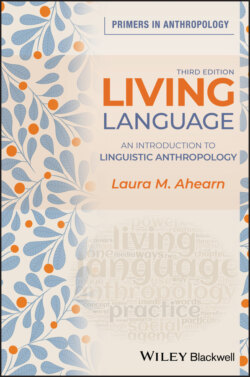Living Language

Реклама. ООО «ЛитРес», ИНН: 7719571260.
Оглавление
Laura M. Ahearn. Living Language
Living Language. An Introduction to Linguistic Anthropology
Table of Contents
List of Figures
List of Tables
Guide
Pages
List of Figures
List of Tables
Preface
Acknowledgments
1 The Socially Charged Life of Language
Example 1: Getting Stoned in San Francisco
Example 2: Losing a Language in Papua New Guinea
Example 3: The Pounded Rice Ritual in Nepal
So, What Do You Need to Know in order to “Know” a Language?
Examples of Linguistic Diversity
Examples of Diversity in Research Topics in Linguistic Anthropology
Keith Basso
Marjorie Harness Goodwin
Bonnie Urciuoli
Alessandro Duranti
Kathryn A. Woolard
James M. Wilce
Key Terms in Linguistic Anthropology
Multifunctionality
Language Ideologies
Practice
Indexicality
The Inseparability of Language, Culture, and Social Relations
2. Gestures, Sign Languages, and Multimodality
Bakhtin’s Double-Voiced Discourse
Goffman’s Participation Framework and Production Format
Speech and the Analysis of Conversation
Gestures and Other Forms of Embodied Communication
Sign Languages
Poetry, Whistled Languages, Song, and Images
3. The Research Process in Linguistic Anthropology
What Kinds of Research Questions Do Linguistic Anthropologists Formulate?
What Kinds of Data Do Linguistic Anthropologists Collect, and with What Methods?
Participant Observation
Interviews
Surveys and Questionnaires
Naturally Occurring Conversations
Experimental Methods
Matched Guise Tests
Written Texts
How Do Linguistic Anthropologists Analyze Their Data?
What Products Do Linguistic Anthropologists Generate from their Research?
What Sorts of Ethical Issues Do Linguistic Anthropologists Face?
4. Language Acquisition and Socialization
Language Acquisition and the Socialization Process
Gaps in the “Language Gap” Approach
Language Socialization in Bilingual or Multilingual Contexts
Language Socialization throughout the Lifespan
Conclusion
5. Language, Thought, and Culture
A Hundred Years of Linguistic Relativity
The Sapir–Whorf Hypothesis
Investigating the Effects of Language on Thought
Language-in-General
Linguistic Structures
Color
Space
Time
Language Use
Conclusion
6 Global Communities of Multilingual Language Users
Defining “Speech Community”
Size and Location of the Community
What Is Shared by the Members of a Speech Community?
The Type of Interactions that Speech Community Members Have
Alternatives to the Concept of “Speech Community”
Speech Areas
Speech Networks
Communities of Practice
Multilingual and Transnational Linguistic Practices
Diglossia, Code-Mixing, and Code-Switching
Diglossia
Code-Switching
Code-Mixing
Heteroglossia
Conclusion
7. Literacy Practices
Literacy Events vs. Literacy Practices
“Autonomous” vs. “Ideological” Approaches to Studying Literacy
Some Examples of Situated Literacy Research
Preschool Literacy Practices in the Southeastern United States
Pema Kumari’s letter
Love-letter Writing in Nepal
Instant Messaging: More like Speech or Writing?
8. Online Communities and Internet Linguistic Practices
Online Literacy Practices
Capitalization, Punctuation, and Emojis
Online Communities, Relationships, and Social Media
Who’s Zoomin’ Who?2
Online Avatars
So Close and yet so Far
Conclusion
9. Performance, Performativity, and The Constitution of Communities
Performance Defined in Opposition to Competence
Performativity
Performance as a Display of Verbal Artistry
Ethnographies of Performance and Performativity
10 Language and Gender
What is Gender, and How Does it Relate to Language?
Do Men and Women Speak Alike or Differently?
Do Women and Men of All Ages and All Ethnic, Racial, and Cultural Backgrounds Share the Same Gendered Differences in Their Language Use?
Some Thoughts on Myths and Realities
11. Language, Race, and Ethnicity
Defining Race and Ethnicity
The Rule-Governed Nature of African American English
Invariant or Habitual “Be”
Copula Deletion
Double Negatives
The Reduction of Final Consonants
Pronouncing the Word “Ask” as “Aks”
Racist Language and Racism in Language
Language and Racial/Ethnic Identities
Conclusion
12. Language Endangerment and Revitalization
Enumerating the Crisis: How Many Endangered Languages are There?
What Dies When a Language Dies?
Why Do Languages Die?
Can Endangered Languages Be Saved?
Conclusion
13 Conclusion
What Is Power?
Hegemony
Foucault’s Power Relations and Discourse
Practice Theory and Power
Agency
The Grammatical Encoding of Agency
Talk About Agency: Meta-Agentive Discourse
Power and Agency In/through/by/of Language
Notes. Chapter 1 The Socially Charged Life of Language
Chapter 2 Gestures, Sign Languages, and Multimodality
Chapter 3 The Research Process in Linguistic Anthropology
Chapter 4 Language Acquisition and Socialization
Chapter 5 Language, Thought, and Culture
Chapter 6 Global Communities of Multilingual Language Users
Chapter 7 Literacy Practices
Chapter 8 Online Communities and Linguistic Practices
Chapter 9 Performance, Performativity, and the Constitution of Communities
Chapter 10 Language and Gender
Chapter 11 Language, Race, and Ethnicity
Chapter 12 Language Death and Revitalization
Chapter 13 Conclusion: Language, Power, and Agency
References
Index
WILEY END USER LICENSE AGREEMENT
Отрывок из книги
Third Edition
Laura M. Ahearn
.....
While it is undoubtedly true that meaning-making involves multiple modalities, as well as the material environment (and, I would add, knowledge of personal histories, cultural norms, social relations, and many other invisible and inaudible aspects of the event at hand), it is still useful to take note of at least one of the gesture categorizations before presenting a few examples of analyses of emergent multimodal discourse.
Perhaps the most common typology of gestures is psychologist David McNeill’s (1992:78–80):
.....